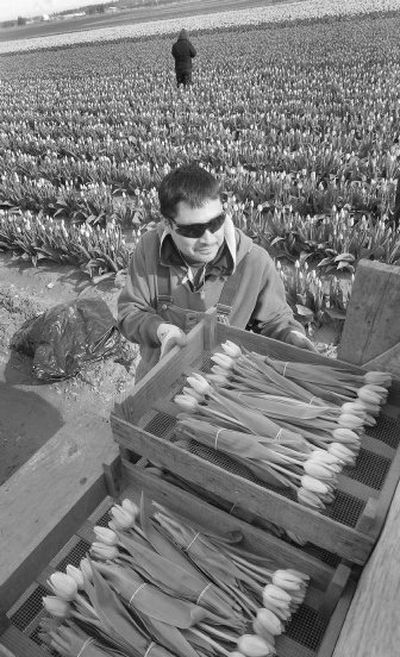A vibrant new burst of color for spring

MOUNT VERNON, Wash. – Fertile farmland, a temperate climate and reliable rainfall make growing bulbs and their flowers a natural fit for the Skagit Valley, growers say.
Agricultural producers take their cues from the weather each year, adjusting the timing of each step of the process to make sure conditions are optimal, said Jeanette DeGoede, who with her husband, Tom, now runs Tulip Town, a farm and display garden on Bradshaw Road west of Mount Vernon.
Members of the DeGoede family first started raising tulips here shortly after immigrating from Holland in the 1940s and 1950s. In the valley, a number of families from Holland started raising the flowers reminiscent of their native land.
“The climate is very similar to the Netherlands,” said Bill Lefeber, a former Skagit Valley tulip grower.
The soil is different though, he said. In Holland’s bulb district, it’s almost like beach sand.
“It makes it a lot easier to harvest the bulbs,” Hulbert said.
Skagit Valley soil is much heavier, so the harvest is more work, he said.
Look at bulb-growing regions on a map of the world, and it’s clear they have a lot in common, said Jack Hulbert, who with brother Tom grows daffodils at Hulbert Farms in La Conner.
Whether in Holland, Ireland, England or the Skagit Valley, bulb-growing regions are at about the same latitude and distance from the ocean, where temperatures and humidity are just right, he said.
In the Skagit Valley, the tulip growing process usually begins in late September. Commercial growers start planting bulbs earlier than the home gardener should, DeGoede said, because they have a lot more bulbs to get in the ground to fill their fields.
The exact timing depends on the weather. Growers want to avoid putting the cool-weather plants into the ground until the soil has cooled.
But it’s important not to wait too long to get started, either.
“The rule of thumb is to have them in before November, because then it starts to freeze,” DeGoede said. “The elements start to work against us.”
Heavy rains are also a challenge, she said. All that water can make the fields too muddy and cause soil to become compacted around the bulbs.
When conditions are right, the tulip bulbs are planted much like potatoes. A bin in the back of a tractor holds the bulbs. As the tractor moves through a field, bulbs drop through a chute and into a furrow in the prepared ground.
At the same time, another implement of the tractor adds bands of fertilizer on either side of the bulb. Finally, a tractor shoe layers a hill of soil over the top of the bulbs.
“If we have a frost, there’s a little more protection for the bulbs,” DeGoede said.
After planting, tulips become a bit lower-maintenance for a while, as growers rely on the ideal conditions of the Skagit Valley to nurture their crop.
“Mother Nature waters them and does all the rest for us,” DeGoede said.
Underground, the bulbs germinate as they soak up rainfall. Eventually, green shoots start to poke up through the soil. When they start to appear also depends on the weather.
“Normally, you’re going to start to see something in the first part of February,” DeGoede said.
If it’s very cold, they’ll peek through later. In a mild year, they’ll come up sooner.
The flowers start to bloom as soon as early spring. The time of the bloom also depends on the variety of tulip.
Commercial harvesting of the flowers begins when they start to bloom. Workers bundle the flowers in groups of 10 and put them in trays. The trays go into a warehouse cooler for an hour so the stems are cool when workers pack the bunches into plastic sleeves for shipping to stores.
The DeGoedes sell cut flowers to stores in the Skagit Valley and the Seattle area. How long tulips last depends on how they’re cared for after they reach the store and consumers’ homes, DeGoede said. If they are fresh and kept cold, they can last up to 10 days. If stored warm, they might only last two.
When the blossoms have peaked, it’s time for a step that DeGoede says has been known to anger people who don’t understand the art of raising tulips. As soon as the flower looks ratty, a crew cuts all of the petals off, right underneath the head of each flower.
“People get so angry at us, but they have to be (topped), because otherwise we have a mess,” DeGoede said. “It’s just a natural process that has to go along with raising tulips.”
With no flower left to devote energy to, a plant sends all of its nutrients to the bulbs. Each plant is attached to multiple bulbs, including the bulb planted the previous fall and new, smaller bulbs.
Allowing petals to remain and fall into the foliage can spread disease to the leaves and bulbs, DeGoede said.
Perhaps tulip admirers disappointed to see fields of decapitated flowers will come, like DeGoede, to appreciate the beautiful green fields of topped plants.
After the flowers are topped, growers give them about three weeks to send nutrients into the growing bulbs. In late May, using a machine called a skimmer, they cut the stems to the ground. A tractor following behind the skimmer scoops out the bulbs. They rise up a belt on the tractor, like potatoes, and the bulbs fall into a hopper.
The bulbs go to a barn, where they’re loaded onto a conveyor belt and washed. Crews pick sprouts off the ends, and the bulbs move along to another belt for sizing.
Next the bulbs, sorted into trays, are placed in an air tunnel for drying and storage. Fans keep air circulating over the bulbs to keep them dry, mold-free and cool until conditions are right for planting again.